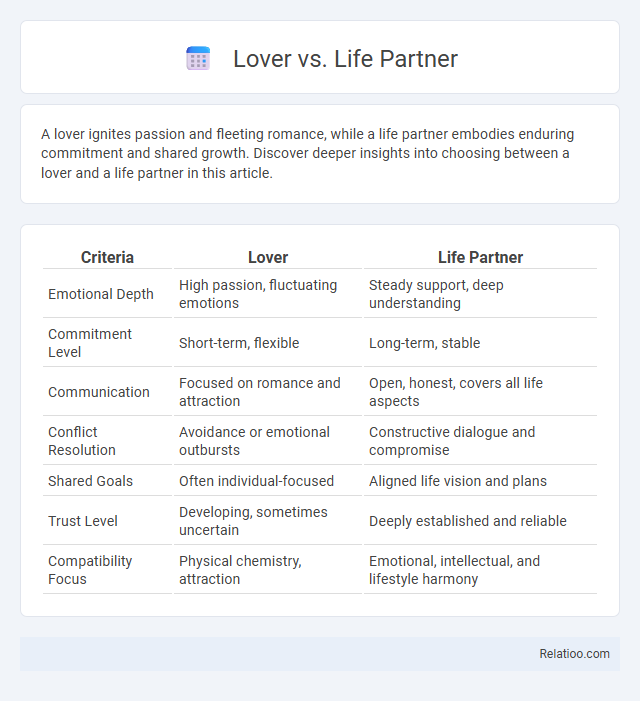A lover ignites passion and fleeting romance, while a life partner embodies enduring commitment and shared growth. Discover deeper insights into choosing between a lover and a life partner in this article.
Table of Comparison
| Criteria | Lover | Life Partner |
|---|---|---|
| Emotional Depth | High passion, fluctuating emotions | Steady support, deep understanding |
| Commitment Level | Short-term, flexible | Long-term, stable |
| Communication | Focused on romance and attraction | Open, honest, covers all life aspects |
| Conflict Resolution | Avoidance or emotional outbursts | Constructive dialogue and compromise |
| Shared Goals | Often individual-focused | Aligned life vision and plans |
| Trust Level | Developing, sometimes uncertain | Deeply established and reliable |
| Compatibility Focus | Physical chemistry, attraction | Emotional, intellectual, and lifestyle harmony |
Understanding the Terms: Lover vs Life Partner
A lover typically refers to a romantic or sexual partner with whom one shares passion and intimacy, often emphasizing emotional and physical connection. In contrast, a life partner signifies a long-term commitment characterized by mutual support, shared responsibilities, and alignment of life goals. Understanding these distinctions helps clarify relationship dynamics and role expectations between emotional fulfillment and sustained partnership.
Emotional Connection: Passion vs Stability
Lover relationships prioritize intense emotional connection marked by passion, excitement, and desire, often centered on romantic intimacy and spontaneity. Life partner bonds emphasize stability, trust, and long-term emotional support, fostering deep mutual understanding and consistent reliability. Role expectations differ as lovers often fulfill needs for emotional intensity and thrill, whereas life partners provide a foundation for security, shared responsibilities, and enduring companionship.
Commitment Levels: Fleeting Romance or Long-Term Bond?
Commitment levels distinguish a lover, often characterized by fleeting romance and intense emotions, from a life partner who embodies a long-term bond built on trust, shared goals, and mutual support. Your expectations guide whether you seek a passionate connection with temporary engagement or a committed relationship fostering growth and stability. Understanding these distinct commitment dynamics helps clarify role expectations and align your emotional needs with the appropriate relationship type.
Communication Styles: Flirting vs Deep Conversations
Lover communication styles often involve playful flirting, light teasing, and expressing attraction, creating excitement and emotional connection through spontaneity. Life partner interactions prioritize deep conversations, active listening, and emotional vulnerability, fostering long-term understanding and mutual support. Your relationship thrives when both flirting and meaningful dialogues balance role expectations, ensuring intimacy and stability coexist.
Shared Values and Goals: Temporary Thrill or Lasting Compatibility
Lovers often bring intense passion and excitement that may fade, while life partners prioritize shared values and long-term goals essential for lasting compatibility. Your role expectations evolve from seeking temporary thrill to fostering mutual respect, trust, and aligned visions for the future. Prioritizing emotional maturity and consistent communication strengthens the foundation beyond fleeting attraction.
Trust and Security: Attraction vs Reliability
Trust and security form the foundation distinguishing a lover from a life partner, where attraction often drives initial passion while reliability ensures long-term stability. Your lover may ignite intense emotional and physical connection, but a life partner embodies consistent support and dependable presence during challenges. Understanding these role expectations helps you prioritize deep trust over fleeting allure for lasting relationship fulfillment.
Growth Together: Personal Development in Each Relationship
Growth together in a lover relationship often centers on emotional intimacy and mutual support, nurturing each other's passions and dreams. In a life partner dynamic, personal development involves long-term commitment, shared responsibilities, and evolving goals aligned with building a future. Understanding your role expectations in each relationship clarifies how to balance individual growth with collective progress, fostering a healthy, evolving connection.
Handling Conflicts: Drama or Resolution?
Handling conflicts with a lover often involves intense emotions and dramatic reactions due to romantic passions, whereas life partners typically prioritize resolution through effective communication and mutual understanding. Role expectations in relationships shape responses to conflicts, with lovers sometimes expecting emotional validation and life partners focusing on problem-solving and compromise. Clear boundaries and shared goals reduce drama and foster constructive resolution in long-term partnerships.
Social Perception: Casual Love vs Accepted Partnership
Social perception often distinguishes lovers as symbols of casual love, characterized by emotional intensity but limited societal endorsement, versus life partners who embody accepted partnerships recognized for stability, commitment, and long-term mutual support. Cultural norms frequently highlight role expectations for life partners, including shared responsibilities and integration into family structures, which contrasts with the more fluid and less defined roles typically associated with lovers. This differentiation affects how relationships are socially validated, influencing public acknowledgment and perceived legitimacy within communities.
Making a Choice: Lover, Life Partner, or Both?
Choosing between a lover, life partner, or both involves evaluating emotional intimacy, long-term compatibility, and mutual goals. A lover provides passionate, short-term connection, while a life partner offers stability, shared responsibilities, and future planning. Aligning expectations around trust, communication, and commitment is essential to making a conscious choice that fulfills personal values and relationship needs.

Infographic: Lover vs Life Partner
 relatioo.com
relatioo.com